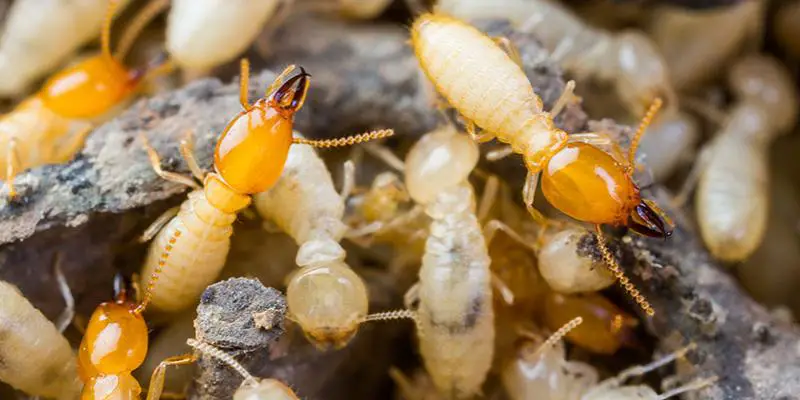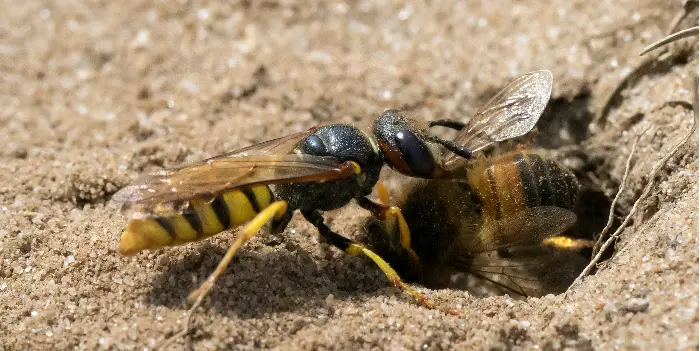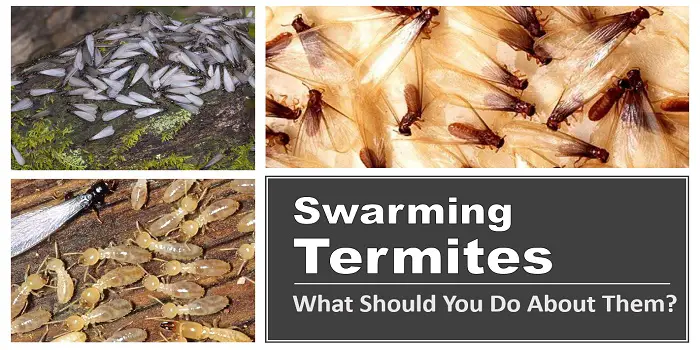
Given the popular conception of termites, imagining them as flying insects may seem to be a stretch.
However, they do indeed grow wings and fly about in the early part of the year after the cold of the winter has released its grip.
Understanding how termites move about and especially why they swarm will help you better prepare to prevent them from nesting inside your home.
This is because the termites that build their nests under your house arrived mostly by flight.
So, instead of slow-moving insects on the ground, termites during the swarming stage can cover a considerable amount of territory in a relatively short time.
What are Swarmer Termites?
Swarming termites (also called alates) are the members of a termite colony that are in charge of reproduction.
While other worker termites in the colony work to damage the structures, the responsibility of alates is to reproduce and sustain their species.
Swarmer termites also have wings that are black or brown in coloring.
These generally fly in groups of dozens, hundreds, or more.
So, when we say “termites swarm,” we mean they are present in large numbers flying in groups that can be hard to deal with.
The basic characteristics of swarmer termites are as follows.
- An antenna that is straight and bead-like in appearance
- Two sets of wings
- Uniformity of size
- Broad waste
Given the sheer number of flying insects, especially in the spring. The termites may blend in with the many others that are buzzing around.
And just like many insects and other creatures, the early spring months bring a good reason they are swarming.
What do they look like?
It is possible to confuse swarmer termites with swarming ants as both have wings and will fly in groups.
This means that if you do see flying insects that look similar to swarmer termites, you will need to take a closer look to see if they are ants.
Ants with wings are generally known as carpenter ants.
During their reproductive cycle, they will have wings much like termites and will swarm in a similar manner looking for mates.
However, there are some differences in their appearance compared to swarmer termites.
- Segmented antennae that are bent much like an elbow
- Large forewings and small hindwings
- Narrow waist
A closer inspection of a flying ant will show the difference between them and swarmer termites.
With swarming ants, you should be considerably less fearful as they do not consume wood and represent little danger to your home or property.
However, their presence inside the home can be annoying, which means that you should take steps to get rid of them if they nest inside.
But just like swarming termites, you will see the flying ants at roughly the same time of the year.
Are they dangerous?
Swarming is a natural process of termites’ life cycle.
It should be noted that it is not so much the termite swarm that is dangerous.
It is when the termites meet their mates and build their underground nests that homeowners should be worried about.
This means that when the swarms begin to abate, you should start looking for telltale signs of nest-building.
Once the mating process has begun, the termites will search for a place to build their nests.
Unfortunately for homeowners, a house with a concrete slab foundation offers an excellent location.
This is because cracks that develop in the foundation allow for the burrowing of the nests.
And the location also provides a food source with the presence of wood.
If your home does not have any wood, then you are safe.
But since almost all homes have a wood structure, then you should be concerned about swarming termites consuming the place in which you live.
Do termite swarmers bite?
Swarming termites do not bite simply because they don’t have any mouthparts that can bite or chew.
Their ultimate goal is to build new colonies in and around your home that can later cause extensive damage.
On the off chance if swarmer termites bite, do not panic. It’s not as dangerous as a mosquito bite.
Unless they nibble you on the body parts with very soft sensitive skin (like between your fingers), you will not feel anything other than just a red spot that lasts for about one to two days.
Just in case you or your pet feels that the termite nibble is getting aggravating, you may need to visit a skin specialist and get some tingling cream.
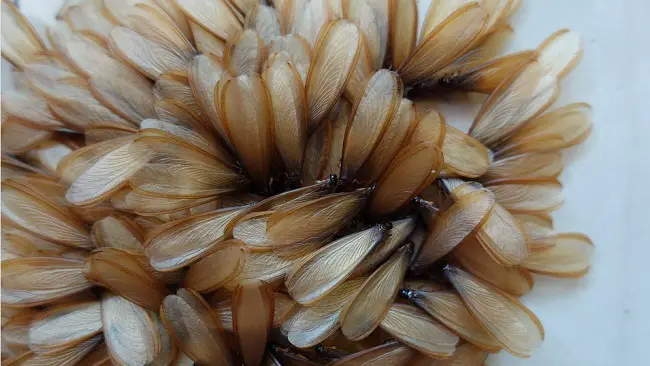
What Causes Termites to Swarm?
When the termites leave their nests in the spring, it is to look for mates that come from other nests.
By developing wings and flying around, they can find their mates far faster, easier, and safer compared to being on the ground.
It is the mating season that causes the termites to swarm in considerable numbers.
The numbers will depend on the nests that produced them, the weather conditions, and how many survived the cold of the winter months.
This means that depending on such factors, you may see a few or quite a few swarming termites flying around your home.
Once the termites have met their mates, they stop swarming; it is time for them to build a nest.
This is when the termites can become dangerous to your home.
Because they build their nests underground, they will lose their wings as they no longer need them.
What are the Signs of Flying Termites?
Although termites are quite voracious, they are still quite small, which means it may take several months, if not several years, before the damage they cause is noticeable.
By the time you see what the termites are doing, they have probably caused extensive damage to your home.
Around the world, millions of dollars in damage are caused by termites.
The damage is so extensive on rare occasions that the home itself must be condemned.
This means that to know if the termites have invaded your home, you will need to look for the early signs along with having annual inspections performed by pest control companies that specialize in termites.
To the untrained eye, seeing evidence of termites in the early stages of invading your home may be quite difficult.
About the only true sign is the mud tubes that lead under the foundation.
Termites live underground when they are building their nests. This means they construct tubes in the mud to access the nest they are building.
You may see evidence of mud tubes along the cracks in the foundation of your home or perhaps along the edge of the foundation.
Such mud tubes are generally small, with a diameter of a pen or pencil and stretching upwards of several feet.
Other signs of a swarming termite infestation include the following.
- Discarded wings near the home
- Wood that is hollowing or damaged by consumption
- Blisters on the wood floors
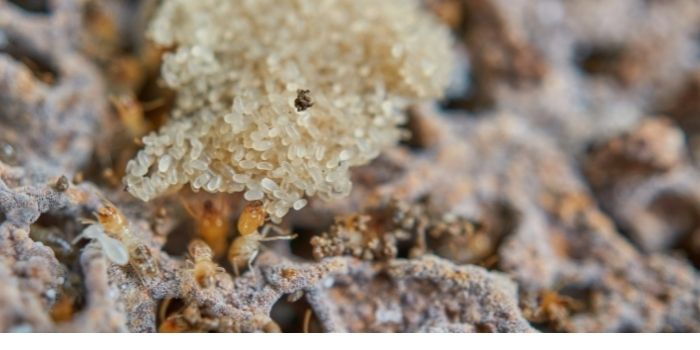
What Time of the Year do Termites Swarm?
Termites will swarm at certain times of the year, depending on where they are located.
The swarming season for termites begins when they awaken from their winter hibernation, and the males take a flight to find their mates.
In places closer to the equator, this means that the swarming season starts in the early months of spring.
In places that are closer to the poles, the time of the swarming will come in the later months of the spring and the early part of the summer season.
This means that, for the most part, termites will swarm when the temperatures reach a certain level that can sustain their activity for most of the day.
In addition, the weather will play a strong role when termites leave their underground nests.
For areas that experience inclement weather, such as strong storms, high winds, and occasional blasts of colder air, this may delay the swarming of the termites.
Once things calm down, then they may take flight in greater numbers.
Termite swarms may last through the summer, depending on the weather conditions.
However, by the fall, the swarms have mostly abated.
But such swarms cannot be ruled out because it also depends on the weather, temperature, and the need to find more mates.
The winter months will provide some peace of mind that the termites are in a relatively dormant stage.
Although depending on the warmth of their nests, they may still be active in consuming the wood that is nearby.
What to Do When Termites Swarm in Your House?
Unfortunately, if you see wood that has been damaged, the termite infestation may have been underway for quite some time.
Discarded wings and mud tubes are usually early signs which means that the damage to your home may not be so extensive.
If you see a mud tube as described or simply suspect that termites might be in your home, the first response should be to get a professional pest control expert.
Do not try to kill termites yourself unless you see them all together.
Let the professional inspect to see how deeply the termites have invaded your home.
This is because they have the knowledge, skills, and equipment to identify and eliminate termite nests.
Because the nests of flying termites are usually deep under the foundation, they can be difficult for homeowners to find and eliminate.
You can set up termite baits on your property to draw them away from your home, but the actual eradication process will need professional guidance.
Once the nests are eradicated, then you can set about repairing any damage that the termites have caused.
Plus, it is advisable that you take steps to prevent future entries of termites into your home.
A combination of bait traps and regular inspections should minimize the damage that termites can do to your home.
The Conclusion
The very thought of termites in the home should be enough to cause fear in any homeowner.
Despite their tiny size, they can cause a considerable amount of damage.
What catches many homeowners off guard is that many people see termites as small, slow-moving insects.
When termites begin their adult lives as flying insects, they are better called swarming termites.
It’s good to understand more about them and how to deal with the situation as soon as you find the infestation signs.
Share the post "What are Termite Swarmers – Are they Dangerous?"

Welcome to ProShieldPest.com. I am Tina Jones. I have been working as a pest removal professional in Winslow, Arizona lately. At present, I love to spend my time with my family as a retiree.
Here I share all my knowledge and experiences to help people understand better how they can stop pests at their homes without actually killing them. Hopefully, the information you will find here will help in safeguarding your home! You can check more about me here.

